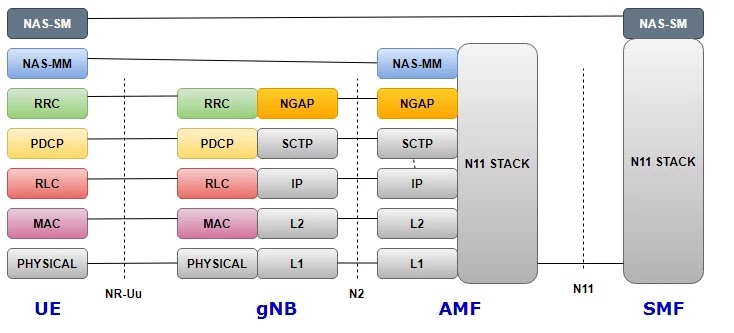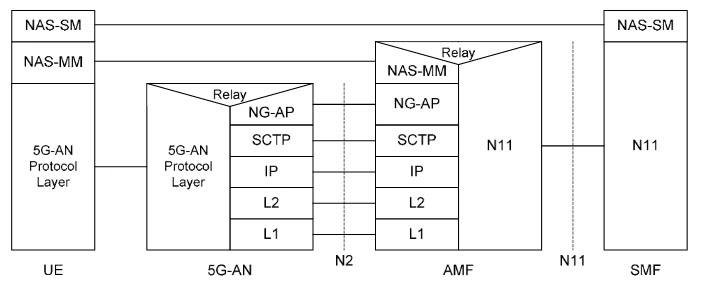The 5G SA Core architecture is describe in the following figure.
The SA Architecture
* The SA architecture can be seen as the "full 5G
deployment", not needing any part of a 4G network to operate.
* The NR base station (logical node "gNB")
connects with each other via the Xn interface, and the Access Network (called
the "NG-RAN for SA architecture") connects to the 5GC network using
the NG interface.
* The continuation of this section refers to the SA
architecture, the NSA being addressed in a subsequent, dedicated, section.
Overview
of the Core Network
* In the SA
deployment option, the 5G System (5GS) is composed of the User Equipment, the
Access Network (including the "New Radio" or NR) and the Core Network
(5GC or 5GCN).
* The service
requirements, as presented in the previous clause, were used as a basis to
define the architecture. The architecture specification (also called, Stage 2) started
with a preliminary study in TR 23.799,
also called "NextGen TR", before being fully specified in TS 23.501, TS 23.502 and TS 23.503.
* The 5GC
architecture relies on a so-called "Service-Based Architecture" (SBA)
framework, where the architecture elements are defined in terms of
"Network Functions" (NFs) rather than by "traditional"
Network Entities. Via interfaces of a common framework, any given NF offers its
services to all the other authorized NFs and/or to any "consumers"
that are permitted to make use of these provided services. Such an SBA approach
offers modularity and reusability.
* The basic (SA,
non-roaming) 5G System architecture is shown below (figure introduced by the
editor):
Overview
of the 5G System architecture
At this stage, only the following essential Network Functions and elements
are highlighted here:
- The User Equipment (UE);
- The (Radio) Access Network [(R)AN];
- The User Plane Function
(UPF), handling the user
data;
- The (external) Data
Network (DN);
- Some remarkable Network Functions (NFs):
- The Application Function (AF), handling the application(s);
- The Access and Mobility management Function (AMF), that accesses the UE and the (R)AN;
- The Session Management Function (SMF) that accesses the UPF.
The other NFs are introduced later.
* The SBA (Service
Based Architecture) approach enables a virtualized deployment. Indeed, a
Network Function instance can be deployed as fully distributed, fully
redundant, stateless and/or fully scalable. Several Network Function instances
can be present within a same NF set. Conversely, the services can be provided
from several locations.
* In other words,
when the services of a specific NF are invoked, this virtualization enables to
route the UE's messages to any capable entity (within a pre-defined set of equivalent
NFs).
* This provides
resiliency: any specific instance of the NF can e.g. be turned off for planned
maintenance, and there will be auto-recovery without any service disruption.
Overview of the Access Network
As a first approach, the architecture of
the 5G AN is extremely simple since it consists in one single entity, the gNB,
which connects to the 5G CN via the NG interface. It may also connect to
another gNB via the Xn interface and/or to the 4G's eNB via the X2 interface,
as shown below in the editor-proposed picture inspired from TS 38.401 and TS 38.420. It also connects to the UE via the NR interface,
not shown on the figure. Note that this AN architecture is rather similar in
its principle to what was developed for LTE with the eNB, as can be seen in TS 36.401.
Overview
of the AN interfaces
References for 5GS
The main specifications for the 5G System are:
[1] TS 23.501, "System Architecture for the
5G System"
[2] TS 23.502, "Procedures for the 5G
System"
[3] TS 23.503, "Policy and Charging Control
Framework for the 5G System"
[4] TR 23.799 "Study on Architecture for
Next Generation System"
[5] TS 38.401 " NG-RAN; Architecture description"
[6] TS 38.420 " NG-RAN; Xn general aspects and principles"
[7] TS 36.401 "Evolved Universal Terrestrial
Radio Access Network (E-UTRAN); Architecture description"















